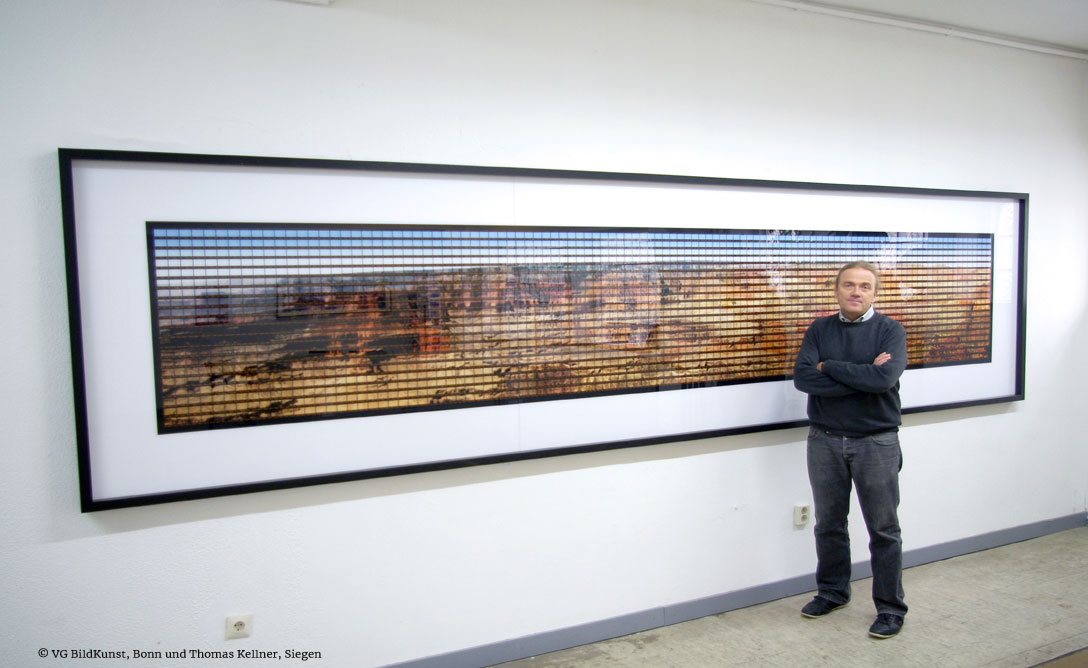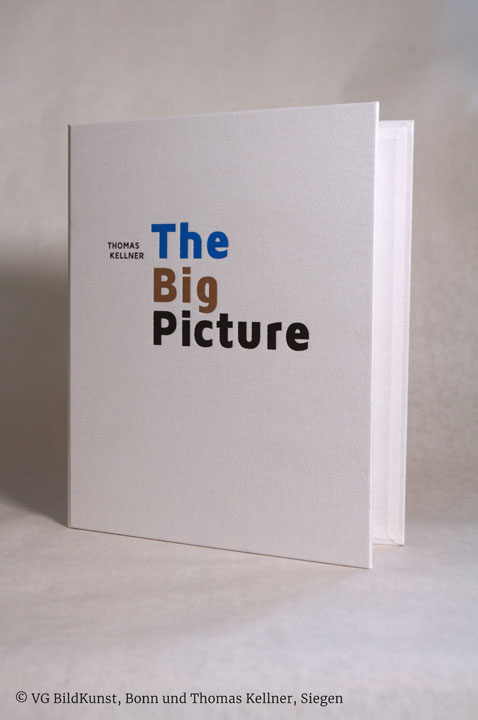
The Grand Canyon
The Grand Canyon is a large canyon located in a national park in the northwest of the state of Arizona. It was first discovered by Europeans in the 16th century. The upper rock layer is 260 million year old Kaibab limestone. At the bottom of the Grand Canyon are gneisses and shales that are 1.8 billion years old. Around 1880 it was developed as a tourist destination and then in 1979 it was included in the UNESCO World Heritage List. It is still considered one of the most famous natural wonders of the world. The huge, colorful 1.6 km deep and 446 km long gorge, which the Colorado River has created in millions of years, is just waiting for numerous tourists to be explored. The North Rim and South Rim of the Grand Canyon fall into the territory of the National Park. About 5 million visitors frequent the Grand Canyon National Park every year.
[... And, we have no other choice but to view the individual image pieces in silent veneration until we too start to sway. ...] Freddy Langer
Art of the Grand Canyon landscape
When someone sees the panorama from a position with a sufficient distance between himself and the fine art photography by an artist the observer will see a landscape of rocks in different shades of red and brown. Also without the indication of the caption it might be obvious that it is about the Grand Canyon National Park in Arizona. It is a phenomenon. From distance you see a whole picture, but close to the surface you get a comprehension for the artwork, made by a lot of little photographs by the artist. It shows details of the landscape and produces a connected and cognizable panorama. It is a new level of art, making plenty photographs to one photograph. It is an individual and unique designed landscape, filled with little pieces of reality, the effigy of Mother Nature.
Creation out of deconstruction
The giant and spacious landscape shows thousands of years of unaffected nature. Added to a produced camera, taking shots of this national park and holding on a moment of a constant process, it makes an accomplishment itself. But taking parts of this monument, standing out for its inimitability, using incoherent details of red and brown rocks, blue sky, light and shadow, tearing them apart of any context and creating with these elements a new inimitability, a new Grand Canyon, is a step to experience the landscape in an unusual manner and open up new vistas. Therefore the fine art photographer works with contrariness. A succession of incoherence and deconstruction resulting in reconstruction and the creation of something unprecedented equals a rebirth and a circular flow leading to a new visual language in form of contact sheets.
Contact sheets by Thomas Kellner
The Grand Canyon National Park is already theme of a lot of artworks. In the Ouevre of Tthis artist it represents a new topic of interest. At least his famous fine art photographies, consisting of a collage of contact sheets, refer to popular motives like the Grand Canyon. But instead of landscape they reproduce fragments of architecture. The Grand Canyon in Arizona forms a first step in another section of popular motives, as it were architecture created by Mother Nature. Inspired by a collage of David Hockney, Thomas Kellner applies himself today to a connection of his method called “visual analytical synthesis” and the theme. At the same time, the title was named after the theme, “Grand Canyon”. Besides this alteration of the motive a bigger dimension of his fine art photographies is the ambition of Thomas Kellner. With 60 photographic films and 2160 individual pictures the described artwork becomes the biggest one the artist has created out of contact sheets. It shows just as the nature theme a volition of achieving new aims and a sign for enhancement of Thomas Kellner and his work with contact sheets.



All Images and Prices here! Interested? Contact me!
Art Photography techniques
The works of the fine art photographer Thomas Kellner from the panorama series "Grand Canyon" are composed of up to 60 films or more than 2160 individual images of 35 mm roll films. The series is divided into three panorama pictures. There is a monumental panorama of 4.5 metres, a medium panorama of 1.40 metres and a small special edition of only 5 images in 20.8 cm format. These films are inserted into the SLR camera during the shootings. The process and material traces are as much essential components of the artistic work, as the image and the visual language. Initially, the compositions built up as photographic collages from negatives, but since 1997, the photo artist Thomas Kellner uses instead of the material collages, printed contactsheets. After developing the film, the artist from Siegen cuts it into strips of equal length and assembles them into one large negative. The horizontal black stripes between the individual rows of images makes the montage techniques clearly visible. In that stripe you can see a continuous image numbering. From the number of films used in the shoot derives the image dimension. Before he begins a project, he sketches the object to be photographed and divides it into square sections so that he can note his planned camera settings. After planning, he begins photographing the object. Between the first and the last picture of a roll can lie several hours. Thus, the specificity of Kellner's art lies, on the one hand, in the predetermined photographic act, and on the other hand, in its intermediary fusion of the genres of photography, film, montage and collage. Through all his technical and photographic steps, he put together an extraordinary body of work, like the panorama of the Grand Canyon.
Citations
"Those poor people. There they were, standing in front of a canyon of which others would later say it was the most beautiful spot on Earth. Magnificent. Tremendous. Stunning. Nevertheless, this deep rift across the landscape was just simply in their way when they were the first non-indigenous people to stand before the depths of the Grand Canyon in 1540. Nothing was further away from this small group of Spanish conquistadors’ minds than to indulge in the beauty of nature. They needed water. Yet the river, that roared by a mile away in the deep — just a trickle if you were looking from up above — could not be reached. For three days, Captain Don García López de Cárdenas and his soldiers looked for a way down into the canyon. It was to no avail. Disappointed, they turned back. Shortly before they almost died of thirst.
(...)
Astonishment and fear are mixed in his romanticizing descriptions combined with scientifically exact particulars. There is talk of crevasses that seem as the doors to hell from their unearthly appearance; and yet, the party would pause time and again ”full of rapture and delight“ in viewing ”these wonderful formations“ through which the Colorado River and its tributaries wound their way.
(...)
All at once, there is the feeling of obsession for new gorges and rock basins, being driven in search of even more of those bizarre-shaped towers and still more of those so surreal colored rocks. Even without one single plant, these rock deserts can hardly be surpassed in their multitude of colors. Iron that oxidizes or even rusts in the rock colors, the cliffs black, brown, red, pink and yellow — and when they connect visually with manganese or copper, then the palette is widened by purple and green hues.
(...)
In these fairy-tale gardens, it is easy to lose yourself in images, rocks and thoughts. If the stone formations are initially compared to castles and Gothic cathedrals, shortly thereafter, they become fabulous animals and legendary characters. Not even those who were immune to any type of witchcraft could withdraw from the power of their magic as Edward Abbey, probably the most renowned writer of the American Southwest, put it when he described the landscapes of rock terraces and mesas. These canyons — so it is said — are filled to the rim with silence. Often, you cannot get rid of the feeling of being the first person that ever entered this area.
(...)
The fact that Thomas Kellner can make the world rock is well known from his architecture artwork. The viewer thinks that by dismantling a building into individual pieces of an image and by tilting the camera several times, the most famous sights in the world — from the Eiffel Tower to the Brooklyn Bridge — begin to rock, to sway, even to dance. Architecture is turned upside down. And the less restraint Thomas Kellner uses in dismantling the building, the more daring the descriptions became for his artwork — from cubist orchestration to radical constructionism, deconstructionism and reconstructionism to, as termed by Irina Chmyreva, analytic synthetism.
(...)
Nevertheless, Kellner displayed humbleness at the Grand Canyon. There, he became a total servant to the landscape and depicted it without any playful interventions. Totally concentrated. Totally serious. And, we have no other choice but to view the individual image pieces in silent veneration until we too start to sway."
Langer, Freddy. 2020. “Grand Canyon.” In Thomas Kellner – the Big Picture, edited by Oliver Seltmann. Lüdenscheid, Berlin: Seltmann+Söhne
Artist's CV
Thomas Kellner was born in Bonn in 1966. He studied art, sociology, politics and economics at the University of Siegen. In 1996 he received the Kodak Young Talent Award, which encouraged him to pursue a life as an artist. Since then, Kellner has lived in Siegen as an artist and curator of photographic exhibition projects. In 2003, he was appointed to the German Society for Photography (DGPh). Kellner's turn to the contact sheet and to increasingly complex compositions began in 1997, first with landscape photographs, then with the creation of a multi-part series of photographs of the Eiffel Tower. Since 2002, The has shown his work in solo exhibitions in Germany, Australia, Russia, China, France, Poland, Denmark, Brazil and the USA, including four solo shows in New York, and has participated in numerous group exhibitions and publications. His works are represented in important private and public collections.
Exhibitions of the Grand Canyon
September 24 – December 11, 2020
Kulturbahnhof Kreuztal, Kreuztal, Germany
March 15 - November 3, 2019
American Museum, Bath, United Kingdom
Publications about the Art of Grand Canyon
Monographs
Kellner, Thomas, ed. 2019. All Shook up: Thomas Kellner's America. Lüdenscheid, Berlin: Seltmann+Söhne.
Langer, Freddy. 2020. “Grand Canyon.” In Thomas Kellner – the Big Picture, edited by Oliver Seltmann. Lüdenscheid, Berlin: Seltmann+Söhne.
Journals and magazines
Heider, and Melanie. 2018. “Kellner Küche Bad: Projekt Künstlerhaus: Thomas Kellner Auf Immobiliensuche.” Top Magazin Siegen Wittgenstein 13 (2): 124–25.
Heider, Melanie. 2020. “Thomas Kellner: The Big Picture: Grand Canyon: 2160 Einzelaufnahmen – Ein Naturwunder.” Top Magazin Siegen Wittgenstein 15 (3): 118–19.
Langer, Freddy. 2020. “Ein Bild, Das Uns Zum Wanken Bringt.” Frankfurter Allgemeine Magazin (Männer Spezial, Oktober 2020): 76–79.
Weber, Ulli. 2018. “Fotokünstler Sucht Neue Wirkungsstätte: Kellner-Ausstellung Beendet Den Kunstsommer.” durchblick 34 (4).
Newspaper articles
Peter Barden. 2019. “"Bis Montagabend Bin Ich Raus": Thomas Kellner Lud Zur Abschiedsausstellung "Good Bye" in Die Friedrichstraße 42.” Siegener Zeitung, September 30. 227.
Weiß, Alexander. 2020. “Monumentaler Grand Canyon: Fotokünstler Thomas Kellner Zeigt „The Big Picture“ Im Kulturbahnhof.” Siegener Zeitung, September 30.
TV contributions
Krczal, Markus. 2020. “Insta-Wettbewerb – the Big Picture.” Westdeutscher Rundfunk. November 25, 2020. Aktuelle Stunde Südwestfalen.
Online publications
Knebel, Alisa. 2020. “Wow! Wie Ein Künstler Den Grand Canyon Nach Südwestfalen Bringt…”. Accessed October 26, 2020.682Z. http://web.archive.org/web/20201026160952/https://suedwestfalen-mag.com/wow-wie-ein-kuenstler-den-grand-canyon-nach-suedwestfalen-bringt/.
Langer, Freddy. 2020. “Ein Bild, Das Uns Zum Wanken Bringt.” Frankfurter Allgemeine Zeitung, October 19. Accessed October 26, 2020.894Z. https://web.archive.org/web/20201026095046/https://www.faz.net/aktuell/stil/drinnen-draussen/fotograf-thomas-kellners-blick-auf-den-grand-canyon-16998152.html.
Trojak, Andreas. 2020. “Analyse Und Synthese – Die Fotokunst Von Thomas Kellner – Ausstellung in Kreuztal.” https://wirsiegen.de/2020/09/analyse-und-synthese-die-fotokunst-von-thomas-kellner-ausstellung-in-kreuztal/323088/.









